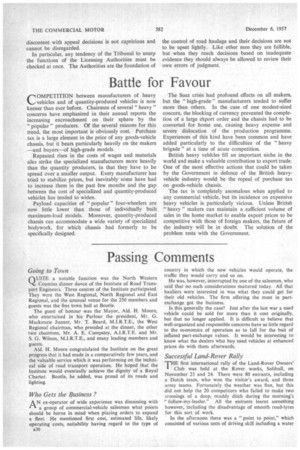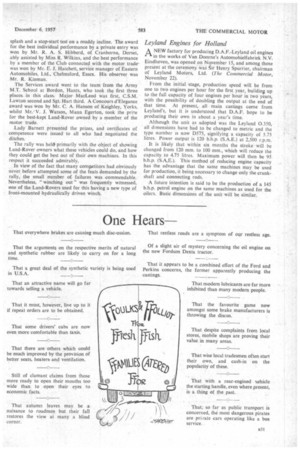Passing Comments
Page 36

Page 37

If you've noticed an error in this article please click here to report it so we can fix it.
.Going to Town QUITE a notable function was the North Western Counties dinner dance of the Institute of Road Transport Engineers. Three centres of the Institute participated. They were the West Regional, North Regional and East Regional, and the unusual venue for the 250 members and guests was the fine town hall at Bootle.
The guest of honour was the Mayor, Aid. H. Moore, who entertained in his Parlour the president, Mr. G. Mackenzie Junner, Mr. T. Beard, M.I.R.T.E., the West Regional chairman, who presided at the dinner, the other two chairmen, Mr. A. E. Cumpstey, A.I.R.T.E. and Mr. S. G. Wilson, M.I.R.T.E., and many leading members and guests.
Aid. H. Moore congratulated the Institute on the great progress that it had made in a comparatively few years, and the valuable service which it was performing on the technical side of road transport operation. He hoped that the Institute would eventually achieve the dignity of a RoyalCharter. Bootle, he added, was proud of its roads and lighting.
Who Gets the Business ?
AN ex-operator of wide experience was discussing with a group of commercial-vehicle salesmen what points should be borne in mind when placing orders to expand a fleet. He mentioned first cost, estimated life, likely operating costs, suitability having regard to the type of
a30 country in which the new vehicles would operate, the traffic they would carry and so on.
He was, however, interrupted by one of the salesmen, who said that no such considerations mattered today. All that hauliers were interested in was what they could get for their old vehicles. The firm offering the most in partexchange got the business.
Is this generally the case? Just after the last war a used vehicle could be sold for more than it cost originally, but that no longer applied. It is difficult to believe that well-organized and responsible concerns have so little regard to the economics of operation as to fall for the bait of inflated part-exchange values. It would be interesting to know what the dealers who buy used vehicles at enhanced prices do with them afterwards.
Successful Land-Rover Rally
THE first international rally of the Land-Rover Owners' Club was held at the Rover works, Solihull, on November 23 and 24. There were 80 entrants, including a Dutch team, who won the visitor's award, and three army teams. Fortunately the weather was fine, but this did not help the 20 competitors who failed to make two crossings of a deep, muddy ditch during the morning's "follow-my-leader." All the entrants learnt something however, including the disadvantage of smooth road-tyres for this sort of work.
In the afternoon there was a "point to point," which consisted of various tests of driving skill including a water splash and a stop-start test on a muddy incline. The award for the best individual performance by a private entry was won by Mr. R. A. S. Hibberd, of Cranborne, Dorset, ably assisted by Miss R. Wilkins, and the best performance by a member of the Club connected with the motor trade was won by Mr. E. J. Hatchett, service manager of Eastern Automobiles, Ltd., Chelmsford, Essex. His observer was Mr. R. Kinrnan.
The Services award went to the team from the Army M.T. School at Bordon, Hants, who took the first three places in this class. Major MacLeod was first, C.S.M. Lawton second and Sgt. Hart third. A Concours d'Elegance award was won by Mr. C. A. Hanson of Keighley, Yorks, whilst Mr.' V. J. Watson, Mann Egerton, took the prize for the best-kept Land-Rover owned by a member of the motor trade.
Lady Barnett presented the prizes, and certificates of competence were issued to all who had negotiated the ditches.
The rally was held, primarily with the object of showing Land-Rover owners what these vehicles could do, and how they could get the best out of their own machines. In this respect it succeeded admirably.
In view of the fact that many competitors had obviously never before attempted some of the feats demanded by the rally, the small number of failures was commendable. Nevertheless, "winching out" was frequently witnessed, one of the Land-Rovers used for this having a new type of front-mounted hydraulically driven winch.
Leyland Engines for Holland
AA NEW factory for producing D.A.F.-Leyland oil engines . in the works of Van Doorne's Automobielfabriek N.V. Eindhoven, was opened on November 15, and among those present at the ceremony waS 4ir Henry Spurrier, chairman of Leyland Motors, Ltd. (The Commercial Motor, November 22).
From the initial stage, production speed will be from one to two engines per hour for the first year, building up to the full capacity of four engines per hour in two years, with the possibility of doubling the output at the end of that time. At present, all main castings come from Leyland's, but it is understood that D.A.F. hope to be producing their own in about a year's time.
Although the unit as adopted was the Leyland 0.350, all dimensions have had to be changed to metric and the type number is now D575, signifying a capacity of 5.75 litres. Power output is 120 b.h.p. (S.A.E.) at 2,500 r.p.m.
It is likely that within six months the stroke will be changed from 120 mm. to 100 mm., which will reduce the capacity to 4.75 litres. Maximum power will then be 95 b.h.p. (S.A,E.). This method of reducing engine capacity has the advantage that the same machines may be used for production, it being necessary to change only the crankshaft and connecting rods.
A future intention is said to be the production of a 145 b.h.p. petrol engine on the same machines as used for the oilers. Basic dimensions of the unit will be similar.
























































































































